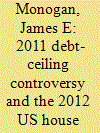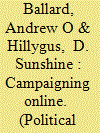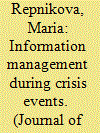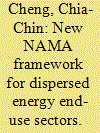|
|
|
Sort Order |
|
|
|
Items / Page
|
|
|
|
|
|
|
| Srl | Item |
| 1 |
ID:
140223


|
|
|
|
|
| Summary/Abstract |
This article considers how a key legislative vote—that is, the August 2011 vote to raise the federal debt ceiling—influenced the 2012 elections for the US House of Representatives. Two outcomes are analyzed: (1) the incumbents’ ability to retain their seats through the 2012 general election, and (2) their share of the two-party vote for members who faced a general-election competitor. In developing this study, the research design was registered and released publicly before the votes were counted in 2012. Therefore, this article also illustrates how study preregistration can work in practice for political science. The findings show that seat retention did not vary with the treatment; however, incumbents who voted against raising the debt ceiling earned an additional 2.4 percentage points of the two-party vote.
|
|
|
|
|
|
|
|
|
|
|
|
|
|
|
|
| 2 |
ID:
146577


|
|
|
|
|
| Summary/Abstract |
Although much of what we know about political advertising comes from the study of television advertising alone, online advertising is an increasingly prominent part of political campaigning. Research on other online political communication—especially candidate websites, blogs, and social media—tends to conclude that these communications are aimed primarily at turning existing supporters into campaign donors, activists, and volunteers. Is a similar communication strategy found in online display ads—those ads placed adjacent to website content? In one of the first systematic analyses of the nature, content, and targets of online display advertising, we examined 840 unique online display ads from the 2012 presidential campaign. We show that the policy content, ad location, and interactive elements of the ads varied based on the audience, with persuasive appeals aimed at undecided or persuadable voters and engagement appeals aimed at existing supporters. Comparing ad content across candidates also found that each side focused on those issues for which the candidate had a strategic advantage. As a consequence, and in contrast to the conclusions of previous research that examines television advertising, we found minimal issue engagement in online advertising.
|
|
|
|
|
|
|
|
|
|
|
|
|
|
|
|
| 3 |
ID:
154823


|
|
|
|
|
| Summary/Abstract |
This article examines the evolving process of China’s information management at sub-national level through the prism of a crisis event. Specifically, it investigates the response of officials and the media to Beijing’s fatal floods of 2012—the heaviest and the deadliest floods the Chinese capital has seen in 60 years. The article draws on ethnographic observations, the analysis of interviews with Chinese media professionals, officials and media scholars, as well as the coverage of the storm by two prominent, but distinct Beijing news outlets: an official daily, Beijing Ribao and a commercial daily, Jinghua Shibao. The analysis reveals various strategies deployed by Beijing authorities to positively shape public opinion, and the media’s creative implementation of official directives. Namely, the two newspapers fused regular news coverage with different styles of positive framing. This process of mutual and diverse adaption highlights the increasingly dynamic nature of China’s crisis communication and public opinion management.
|
|
|
|
|
|
|
|
|
|
|
|
|
|
|
|
| 4 |
ID:
098599


|
|
|
|
|
| Publication |
2010.
|
| Summary/Abstract |
This paper presents a new approach for a nationally appropriate mitigation actions (NAMA) framework that can unlock the huge potential for greenhouse gas mitigation in dispersed energy end-use sectors in developing countries; specifically, the building sector and the industrial sector. These two sectors make up the largest portions of energy consumption in developing countries. However, due to multiple barriers and lack of effective polices, energy efficiency in dispersed energy end-use sectors has not been effectively put into practice. The new NAMA framework described in this paper is designed to fulfill the demand for public policies and public sector investment in developing countries and thereby boost private sector investment through project based market mechanisms, such as CDM. The new NAMA framework is designed as a need-based mechanism which effectively considers the conditions of each developing country. The building sector is used as an example to demonstrate how NAMA measures can be registered and implemented. The described new NAMA framework has the ability to interface efficiently with Kyoto Protocol mechanisms and to facilitate a systematic uptake for GHG emission reduction investment projects. This is an essential step to achieve the global climate change mitigation target and support sustainable development in developing countries.
|
|
|
|
|
|
|
|
|
|
|
|
|
|
|
|
|
|
|
|
|